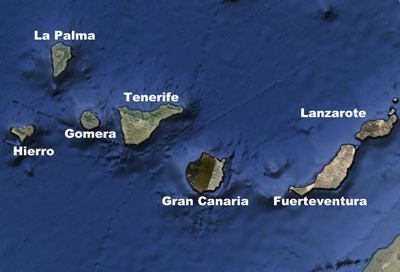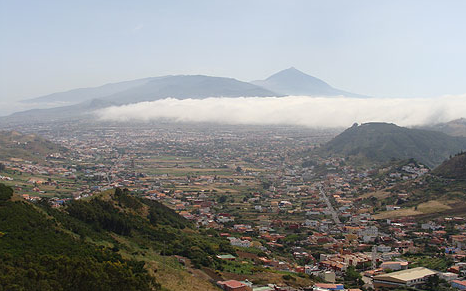For do not forget your bathing costume for use after walking! * The Tenerife coast has a temprate climate throughout the year, but once you get to 900 meters, it is a little cooler. 2000m and above, one should always be fitted out well, as it involves hiking in the mountain range.
In July-August it will be very warm, but never extreme. We then travel more in the laurel forest, on mount Teide and in the north, where it is always colder. In the winter time snow can lie on mount Teide! In particular meterological conditions are subject to changes in the program. A travel insurance is recommended! Participation in the events at your own risk.
You should be in sound health to take part in hiking, especially when ascending mount Teide.

- Good hiking boots
- Backpack for a big waterbottle and picknick
- Walking Sticks
- Gore-Tex Jacket
- Sweater
- 3 -4 T-Shirt to change
- 2 hiking-trousers
- headlamp for night hiking
- sun hut and sunscreen
- Swimming suite
- Aspiring and other 1st aid stuff
- Dress for evening
 Geographical position: 16. and 17. degree of western longitude, 28. degree of northern latidude ; circa 300 km west from Marocco, 1300 km distance from Spain.
Geographical position: 16. and 17. degree of western longitude, 28. degree of northern latidude ; circa 300 km west from Marocco, 1300 km distance from Spain.
Tenerife, Fuerteventura, Gran Canarias, Lanzarote, La Palma, La Gomera, El Hierro und la Graciosa.
Climate Tenerife: one of the mildest Places in Europe.
Clima: Canary Island offers the mildest climate of Europe and we can say the mildest in the world. In Wintertime the daily temprature is between 20-24 C , in the night between 16-18 degree near the coastline. Because of the extreme hight of the island here you can find a lot of different climate-levels and micro climates.
On the coastline the winter sea-temperatures are between 18-20 C degrees and some small rainfall can happen between November and March. In sommer temperatures from April – Oktober are between 26 – 30 C There are no rainfalls in this period. The Atlantic warms up to 23-25 C. degrees.
There are anyway different tempratures in the nord and the south part of the island till 5 - 10 degrees. When you arrive in mountain regions at 1000 - 2000 meter over sealevel tempratures get 10-15 degrees colder . In wintertime it can get cold and snowy on top of the Teide.
We reccomend to pack always a goretex- jacket in your backbag when you climb the mountains of Tenerife.
Tenerife Surface: 2034 km2, Length 83 km, Width 51 km Tenerife is an autonome region of Spain
Tenerife is an autonome region of Spain
Inhabitantes: 900 000 consisting in Canarian population and Immigraters from many different countries of Europe, Africa and South-America. The aborigin population of the islands were the "Guanches". After a big resistence and defence against the spanish conquistatores, Tenerife in 1495 becames incooperated as the last of the Canarian Islands under Spain Government.
Capital: Santa Cruz de Tenerife has 200 000 inhabitants, here is located the Canarian Government: Cabildo de Islas Canarias. To Tenerife belong the western islands : Gomera, La Palma and El Hierro.
Gran Canaria an autonome region of Spain with own government and to it belong the island Fuerteventura and Lanzarote and La Graciosa.
The Port of Santa Cruz is one of the most important habours of Spain for the export to America, Africa.
Main towns inhabitants : La Laguna 122 00, La Orotawa 36 000, Los Realejos 33 000, Puerto de la Cruz 45 000, Icod de Los Vinos 22 000, Arona 22 000, Adeje 15 000.
Religion: Christian Catolic.
Language: Spanish ( Castellano)
Economy: turisme is the biggest income 35%.
Agricultur 20 % is growing: Tomatoes, Bananas, Papaya, Mango, Avocado, potatoes, flowers, goats and sheepherds, cheese, whine...
Fishing and fish-cultur ca.10%: tuna , Bonito.
Others 11% Construction, Industrie 10%,
Big investments in solar and wind "renoveable Energies
The flora of Tenerife
- The islands have because of their convenient location amid the cool Canary current and the extreme altitude of the mountains, a diverse vegetation (up to 10 different climate zones), many plant species are indigenous to the islands, some unique to Tenerife (endemic). The Canary Island pine (Pinus canariensis) forms large forests. In the arid south of the island succulent spurge (Euphorbia canariensis) and prickly pears are located. Another characteristic plant is the Canary Dragon tree (Dracaena draco) - a 1000 year old and impressive specimen at Icod de los Vinos is found.
- The Laurel forests are of particular interest because these were made extinct in the Mediterranean during the last ice age and today are considered "Vegetable relics". They once covered large areas of southern Europe. (See Plant Guide to the Canary Islands by Thomas K. Mueller) Almost all plant species are now under strict protection.
- The Teide Snake Heads (Echium wildpreti), the Canary Bellflower (Canarina Canarensis) stand out among the many endemic species. The botanist and explorer Alexander von Humboldt Was particularly impressed by the flora of Tenerife when he visited the island in 1799.
- In addition to the native plants, many plants from around the world dominate the island. Wild cacti come from America, as well as the huge bushes of the poinsettia, a plant that is sold in Central Europe in pots for Christmas. The distinctive flower of the South African Strelitzia is a popular souvenir for tourists. Eucalyptos, African Mimose, al type of Palmtrees, tropical plants are cultivated as Mango, Avocados, Passionfruit, Bananas , Papaya ecc.
The fauna of Tenerife
- The Canary islands have few mammals other than wild cats, muflon, wild goats . Many wild rabbits populate the whole island. There are no poisonous snakes but many species of medium to large endemic lizards (Galliotia).
- The animal kingdom is connected mostly to the the bird world - some are typical to Tenerife such as the Teide finch or the wild form of the canary, tower-hawks and Great Grey Shrike, Barbary partridge, crow, fish eagles and yellow-billed diver.
- The are several species of butterfly endemic to the Canary Islands such as the Canarian white (Pieris cheiranthi), the Canary Red Admiral (Vanessa vulcania) and the Canary Speckled Wood (Pararge xiphioides).
Delfin - Marine animals: A special feature is the pilot whale, which are in large numbers found in the 1500m deep strait between Tenerife and La Gomera. There are few cities in the world where so many whales and dolphins make their home.This means that protection of this area is well enforced. When diving, one often encounters the sea turtle (Caretta caretta), small species of sharks, rays, barracuda, parrot fish, many tropical fishes etc




 +34 (0) 634 04 80 57
+34 (0) 634 04 80 57